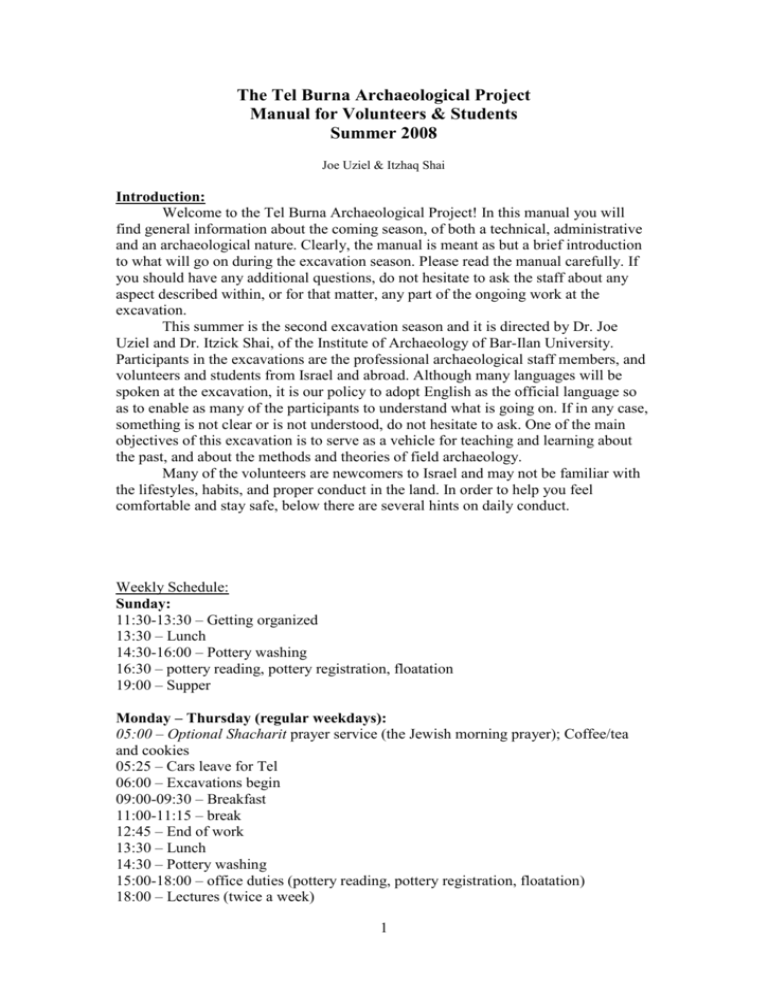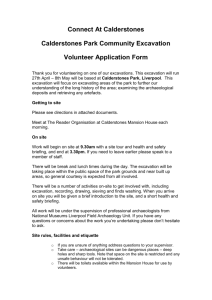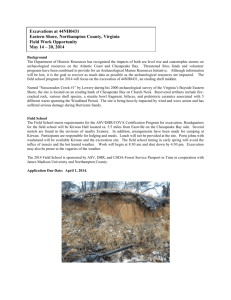English_Volunteers_guidelines_2011
advertisement

The Tel Burna Archaeological Project Manual for Volunteers & Students Summer 2008 Joe Uziel & Itzhaq Shai Introduction: Welcome to the Tel Burna Archaeological Project! In this manual you will find general information about the coming season, of both a technical, administrative and an archaeological nature. Clearly, the manual is meant as but a brief introduction to what will go on during the excavation season. Please read the manual carefully. If you should have any additional questions, do not hesitate to ask the staff about any aspect described within, or for that matter, any part of the ongoing work at the excavation. This summer is the second excavation season and it is directed by Dr. Joe Uziel and Dr. Itzick Shai, of the Institute of Archaeology of Bar-Ilan University. Participants in the excavations are the professional archaeological staff members, and volunteers and students from Israel and abroad. Although many languages will be spoken at the excavation, it is our policy to adopt English as the official language so as to enable as many of the participants to understand what is going on. If in any case, something is not clear or is not understood, do not hesitate to ask. One of the main objectives of this excavation is to serve as a vehicle for teaching and learning about the past, and about the methods and theories of field archaeology. Many of the volunteers are newcomers to Israel and may not be familiar with the lifestyles, habits, and proper conduct in the land. In order to help you feel comfortable and stay safe, below there are several hints on daily conduct. Weekly Schedule: Sunday: 11:30-13:30 – Getting organized 13:30 – Lunch 14:30-16:00 – Pottery washing 16:30 – pottery reading, pottery registration, floatation 19:00 – Supper Monday – Thursday (regular weekdays): 05:00 – Optional Shacharit prayer service (the Jewish morning prayer); Coffee/tea and cookies 05:25 – Cars leave for Tel 06:00 – Excavations begin 09:00-09:30 – Breakfast 11:00-11:15 – break 12:45 – End of work 13:30 – Lunch 14:30 – Pottery washing 15:00-18:00 – office duties (pottery reading, pottery registration, floatation) 18:00 – Lectures (twice a week) 1 19:00 – Supper Friday: Same as regular weekdays till end of dig at 12:00 12:00 – Drive to kibbutz Free time until Sunday morning. Communications: Internet: There will be Wi-Fi net in the camp which anyone can connect to. General Administration: Health: If you should have any health problem, please notify Joe, Itzick Debi or Amit at once. The dig office has first aid supplies for cuts and bruises. For more serious injuries/ailments there is a nurse on the kibbutz, and if necessary, the nearest hospital is a 20 minute drive. Remember – all volunteers must have up-to-date comprehensive medical insurance. Shopping: There is a small supermarket on the kibbutz that is open most afternoons (exact times will be posted). This shop carries a variety of foods, drinks, cosmetics, etc. In addition, next to the communal area of the dig there will be a small shop selling drinks, etc. Pool: The pool is open during the afternoons and you should feel free to use it. If you are asked, tell them that you are from the dig. In any case, do not use the pool if the lifeguard is not present. Safety and Security: The safety and security of all of the participants in the excavation is at the absolute top of our priorities. Please follow the instructions given here, as well as any brought up during the dig. This is based on years of experience and familiarity with the Tell and its environs. On the Tell and its surroundings there are many pits and holes, some of which are hard to see. Please! Do not walk around the Tell by yourself, save for within the excavation areas and going to the designated dining areas, logistic zone and toilets. In any case, do not leave the excavation area without notifying the staff member in charge of your area. Also, please use the “buddy system” when going to the toilets. Since many of you have little experience in such hot climates and field conditions, it is important to follow some basic patterns of behavior while in the field: 1) Always wear your hat. 2) It is strongly advised to wear lightweight, closely woven, cotton long-sleeve shirts and long pants. Although we all use sunblock, it does not remain effective for more than 1-2 hours and melanoma is not a fun experience … 3) Sunblock should be applied regularly and copiously, approximately once every 2 hours. Even when working under a tarpaulin, the harmful UV rays can still get thru. Make sure to use sunblock with a high “SPF.” 4) Drink copious amounts of water. Drink much more than you think is necessary. Most often, people underestimate the amount of water that they require during the day (while doing physical activity, on a hot day, one should drink about 5-8 liters [ca. 5-8 quarts]!!). This can lead to fatigue, and in severe cases, to dehydration or heat-exhaustion (both of which can be fatal …). It is suggested to use your own canteen that you can refill regularly from the larger water containers. If during the excavation you are feeling tired, dizzy, flushed, 2 nausea, and/or a lack of thirst or appetite, these could be the first signs of dehydration/heat-exhaustion. If you are not feeling well, please notify the staff at once! One of the best ways to check for dehydration is the “urine test” (something that should be done in private …): If your urine is a darkish yellow color, you are not drinking enough! 5) Personal hygiene is extremely important in hot environments. This is the number one way to fight intestinal and other diseases. Keep in mind that visitors to Israel will be “meeting” new “bugs” that would just love to conduct a short “visit.” Thus, make sure to wash your hands with soap and water before eating, and after using the bathroom. This is true both in the field and in camp. If you should feel that you are coming down with something (headaches, stomach ache, etc.), please notify the staff immediately, both during the excavation and after. If necessary, you can return to the Kibbutz early and/or miss a day at the excavation to recuperate. It is better to miss one day than get very sick … (see health section above). 6) We would like to know where all the volunteers are at all times. If you have to go to the bathroom during the excavation, please notify your supervisor. If you want to leave the kibbutz for a day, please notify us. 7) In any case, if you should have any questions, concerns, etc., do not hesitate to ask the staff. The Excavation What is a Tell: A Tell (in Arabic, or Tel in Hebrew) is an ancient Semitic word (appearing in Akkadian and in the Bible [Josh 8:28]), which originally means a ruined settlement. In modern archaeological terminology, a Tell is a multi-period site in which layer after layer of settlement activity from different periods were deposited, one layer on top of the other. In some cases (such as Tell es-Safi/Gath, Hazor, Megiddo, Rehov, etc.), there can be multiple layers (at times even more than 20) representing many periods. The cycle on such as site is that of construction, living, and destruction, abandonment or rebuilding. This cycle is repeated again and again, thus creating the various levels or strata. Each stage in the cycle represents at least one level that we subsequently try to uncover during the excavations. It is the archaeologist job to uncover the various finds and architecture and relate them to the various stages in the “life-cycle” of the Tell. The Archaeological Excavation: The primary goal of archaeological research is to uncover information and gain insights about the cultures, lifestyles and surroundings of pre-modern people. In order to do this, we attempt to uncover the material culture of these people as well as study the environment, ecology and related aspects. Due to the ravages of time, rarely do we find archaeological remains in pristine condition, as they were in ancient times. Often, we find only partial remains of the various types of finds. Thus, in order to enable the study and understanding of the remains, we must excavate and record the finds in as careful a manner as possible. Remember! In the end, archaeology is a destructive science. What we have excavated can never be returned to its original state. If we do not excavate and record properly, the information will be lost forever. 3 There are numerous terms that you will hear used during the excavation. Here are some of them: Stratum – A distinct level of human activity on the tell. It usually implies a level that is seen in many places on the tell. Locus (plural loci) – The smallest functionally definable area in the archaeological excavation. A locus can be of different sizes, depending on the type of activity that it represents, such as a floor, a pit, a dump, a foundation trench, etc. Basket – The unit that is used to differentiate between the various finds deriving from a single context. For example, one can finds pottery, bones, scarabs, etc. from the same locus. Each will be put in a separate basket. Throughout the entire excavation process we try to work as cleanly and orderly as possible. That means that on a regular basis we collect, clean, straighten, brush, etc. Although it might appear that archaeologists suffer from a bad case of obsessivecompulsive disorder, in fact, a clean, orderly excavation enables one to reveal, observe, and understand, more of the archaeological evidence. The rule of thumb is that in any given area that one is excavating, one should try to peel away the features, loci, layers etc. in an orderly fashion. That means that we won’t mix between two levels but rather try to excavate one level before going to the next. Or, if we are excavating a pit that is dug into earlier levels, we will excavate the contents of the pit itself, before we dig the surrounding, earlier, material. In most cases, one should excavate in a level, horizontal manner (save when excavating features that are sloping …). In most cases, you will be excavating in 5X5 m squares. As one goes down in a square it is important to keep the sides of the square (the balks) vertical. They should not slope either inwards or outwards. Otherwise, the size of square will change as we excavate. At the end of each day of excavation (but on other occasions as well ..), the area that was excavated is brushed clean. Among other reasons, this is to enable the dampness during the night to help outline features that will be seen first thing in the morning. While excavating if you should reveal a find (pottery, bone, etc.), do not remove it from its place. First one must excavate the area around it in order to uncover the more general context from which the finds is derived. This will enable us to better understand the stratigraphic context of the find. Bottom Line All told, the process of excavation is not an impossible thing to learn. If you combine what is written here with the instructions from your supervisor, along with the experience that you will gain as you are working, AND some healthy common sense, you will soon see that you can become proficient and quite qualified at field archaeology. Most important – keep your eyes open to the various finds and the subtle changes as you work and don’t be afraid to ask, comment or make suggestions. We hope you have a fruitful, enlightening, and interesting season with many exciting and exhilarating discoveries. Good luck and enjoy!! 4






